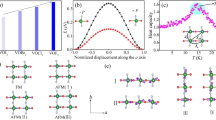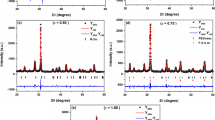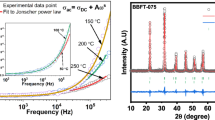Abstract
The novel lead-free Bi-based ferroelectric system with perovskite structure (1 − x) Bi1/2K1/2TiO3 − x BiScO3, chemically designed to show a ferroelectric morphotropic phase boundary (MPB) and high piezoelectric response, was synthesized by the conventional solid-state reaction method for compositions with 0 ≤ x ≤ 0.3. X-ray diffraction analysis shows that the samples possess perovskite-type structure for x < 0.3 and reveals a phase evolution in the symmetry from tetragonal for x < 0.1 to pseudocubic for 0.1 ≤ x ≤ 0.3. Electrical and piezoelectric properties of ceramic samples were systematically investigated, and results indicate that a ferroelectric MPB is not formed, but instead a transition from conventional ferroelectric to relaxor ferroelectric behavior occurs when increasing the (Bi, Sc) content between 5 and 10%. The origin of this unexpected effect, and its implications in the design of novel lead-free piezoelectric materials are discussed.











Similar content being viewed by others
References
Shrout TR, Zhang SJ (2007) J Electroceram 19:113. doi:10.1007/s10832-007-9047-0
Guo R, Cross LE, Park SE, Noheda B, Cox DE, Shirane G (2000) Phys Rev Lett 84:5423. doi:10.1103/PhysRevLett.84.5423
Zhou CR, Liu XY, Li WZ, Yuan CL (2009) J Phys Chem Solid 70:541. doi:10.1016/j.jpcs.2008.12.013
Yang ZP, Liu B, Wei LL, Hou YT (2008) Mater Res Bull 43:81. doi:10.1016/j.materresbull.2007.02.016
Takenaka T, Nagata H (2005) J Eur Ceram Soc 25:2693. doi:10.1016/j.jeurceramsoc.2005.03.125
Zhou CR, Liu XY, Li WZ, Yuan CL (2009) Solid State Commun 149:481. doi:10.1016/j.ssc.2008.12.034
Saito Y, Takao H, Tani T, Nonoyama T, Takatori K, Homma T, Nagaya T, Nakamura M (2004) Nature 432:84. doi:10.1038/nature03028
Tinberg DS, Trolier-Mckinstry S (2007) J Appl Phys 101:024112. doi:10.1063/1.2430627
Ogihara H, Randall CA, Trolier-Mckinstry S (2009) J Am Ceram Soc 92:110. doi:10.1111/j.1551-2916.2008.02798.x
Takenaka T, Maruyama K, Sakata K (1991) Jpn J Appl Phys 30:2236. doi:10.1143/JJAP.30.2236
Eitel RE, Randall CA, Shrout TR, Park SE (2002) Jpn J Appl Phys 41:2099. doi:10.1143/JJAP.41.2099
Zhang SJ, Randall CA, Shrout TR (2003) Appl Phys Lett 83:3150. doi:10.1063/1.1619207
Eitel RE, Randall CA, Shrout TR, Rehrig PW, Hackenberger W, Park SE (2001) Jpn J Appl Phys 40:5999. doi:10.1143/JJAP.40.5999
Chaigneau J, Kiat JM, Malibert C, Bogicevic C (2007) Phys Rev B 76:094111. doi:10.1103/PhysRevB.76.094111
Hungría T, Houdellier F, Algueró M, Castro A (2010) Phys Rev B 81:100102(R). doi:10.1103/PhysRevB.81.100102
Rodel J, Jo W, Seifert KTP, Anton EM, Granzow TK, Damjanovic D (2009) J Am Ceram Soc 92:1153. doi:10.1111/j.1551-2916.2009.03061.x
Li XH, Jiang M, Liu J, Zhu JL, Zhu XH, Li LH, Zhou Y, Zhu JG, Xiao DQ (2009) Phys Status Solidi A 206:2622. doi:10.1002/pssa.200925036
Datta K, Thomas PA (2010) J Appl Phys 107:043516. doi:10.1063/1.3309064
Zhong W, Vanderbilt D (1994) Phys Rev Lett 73:1861. doi:10.1103/PhysRevLett.73.1861
Hiruma Y, Aoyagi R, Nagata H, Takenaka T (2005) Jpn J Appl Phys 44:5040. doi:10.1143/JJAP.44.5040
Zhao SC, Li GR, Ding AL, Wang TB, Yin QR (2006) J Phys D 39:2277. doi:10.1088/0022-3727/39/10/042
Hou YD, Hou L, Huang SY, Zhu MK, Wang H, Yan H (2006) Solid State Commun 137:658. doi:10.1016/j.ssc.2006.01.023
Li ZF, Wang CL, Zhong WL, Li JC, Zhao ML (2003) J Appl Phys 94:2548. doi:10.1063/1.1592290
Hou L, Hou YD, Song XM, Zhu MK, Wang H, Yan H (2006) Mater Res Bull 41:1330. doi:10.1016/j.materresbull.2005.12.010
Wada T, Toyoike K, Imanaka Y, Matsuo Y (2001) Jpn J Appl Phys 40:5703. doi:10.1143/JJAP.40.5703
Yang JF, Hou YD, Wang C, Zhu MK, Yan H (2007) Appl Phys Lett 91:023118. doi:10.1063/1.2754366
Cross LE (1987) Ferroelectrics 76:241
Jiménez R, Jiménez B, Carreaud J, Kiat JM, Dkhil B, Holc J, Kosec M, Algueró M (2006) Phys Rev B 74:184106. doi:10.1103/PhysRevB.74.184106
Hiruma Y, Marumo K, Aoyagi R, Nagata H, Takenana T (2008) J Electroceram 21:296. doi:10.1007/s10832-007-9146-y
Bokov AA, Ye ZG (2006) J Mater Sci 41:31. doi:10.1007/s10853-005-5915-7
Burton BP, Cockayne E, Waghmare UV (2005) Phys Rev B 72:064113. doi:10.1103/PhysRevB.72.064113
Trolliard G, Dorcet V (2008) Chem Mater 20:5074. doi:10.1021/cm800464d
Acknowledgements
L. M acknowledges the financial support of the Spanish Consejo Superior de Investigaciones Científicas (CSIC, JAEPre086). This research has been funded by Ministerio de Ciencia e Innovación (MICINN, Spain) through the MAT2010-18543 project. The authors are also grateful for the technical support provided by Mrs I. Martínez.
Author information
Authors and Affiliations
Corresponding author
Rights and permissions
About this article
Cite this article
Martín-Arias, L., Castro, A. & Algueró, M. Ferroelectric phases and relaxor states in the novel lead-free (1 − x) Bi1/2K1/2TiO3 − x BiScO3 system (0 ≤ x ≤ 0.3). J Mater Sci 47, 3729–3740 (2012). https://doi.org/10.1007/s10853-011-6222-0
Received:
Accepted:
Published:
Issue Date:
DOI: https://doi.org/10.1007/s10853-011-6222-0




